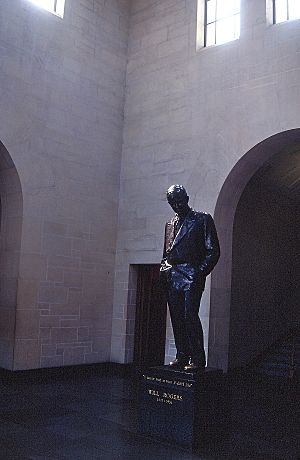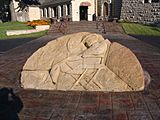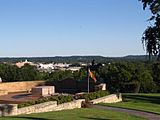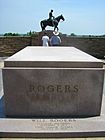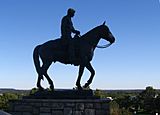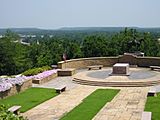Will Rogers Memorial facts for kids
 |
|
| Established | 1938 |
|---|---|
| Location | Claremore, Oklahoma |
| Type | History and art museum |
The Will Rogers Memorial Museum is a special place in Claremore, Oklahoma. It's a museum that honors a famous entertainer named Will Rogers. The museum is about 19,052 square feet big.
Inside, you'll find many things from Will Rogers' life. There are old items, photos, and his writings. You can also watch his documentaries, speeches, and movies in a theater. Will Rogers' tomb is on the museum's 20-acre grounds. It looks out over Claremore and Rogers State University.
For a long time, the museum was managed by a group called the Will Rogers Memorial Commission. But in 2016, the Governor of Oklahoma signed a law. This law changed things. Now, the museum and everything it owns is managed by the Oklahoma Historical Society. This is another state group that takes care of history.
Contents
The Museum's Story
Will Rogers was born near Oologah, Oklahoma. He bought the land where the museum now stands way back in 1911. It was a 20-acre plot with a great view of the Tiawah Valley. He planned to build his retirement home there. After he passed away, the land went to his family.
In 1937, during a tough time called the Great Depression, Will's wife, Betty, gave the land to the state of Oklahoma. She wanted it to be a memorial for her husband. She also gave all of Will's papers and many of his personal items. These became the first things in the museum's collection.
The Oklahoma government gave $200,000 to build the museum. The first building was made of limestone and was about 15,000 square feet. It was designed by John Duncan Forsyth. Construction started on April 21, 1938. Will's sister, Sallie Rogers McSpadden, helped start the digging. The museum was finished on November 4, 1938. This would have been Will Rogers' 59th birthday. The museum opened that same year, three years after he passed away.
In 1983, the museum got a big addition. It added about 11,000 square feet. This new space included a theater, a bigger gift shop, offices, and more room for the museum's collections. The collections are now grouped by the different parts of Will Rogers' life and career.
Inside the Museum
The main hall, called the rotunda, has a famous sculpture of Will Rogers. It was made by an artist named Jo Davidson. On the base of the statue, there's a famous quote from Will Rogers: "...I never met a man I didn't like." This statue is a copy of another one that represents Oklahoma in the National Statuary Hall at the United States Capitol.
The addition built in 1983 has a large library and offices. These areas are used by people who want to research Will Rogers. This part of the museum is about 2,400 square feet. It holds over 2,000 books about Will Rogers and other topics. These topics include Native Americans, family history, old theater shows, early movies, and history from 1879 to 1935. The museum also has about 18,000 photos. Plus, there are thousands of original writings, private letters, and personal papers. They also have movies, home videos, and audio recordings.
Outside the Museum
Will Rogers' tomb is located outside the museum building. It looks out over the city of Claremore. Other members of his family are also buried there. These include his wife, Betty (who passed away in 1944), and three of their four children: Fred Stone Rogers, Mary Amelia Rogers Brooks, and James Blake (Jim) Rogers. Jim's wife, Marguerite Astrea Kemmler Rogers, and Jim's oldest son, James Kemmler (Kem) Rogers, are also buried there.
Working with the Oklahoma Historical Society
On March 7, 2016, Governor Mary Fallin signed a new law. This law put the Will Rogers Memorial Commission under the control of the Oklahoma Historical Society. This meant that both the Will Rogers Memorial Museum and the Dog Iron Ranch (Will Rogers' birthplace in Oologah) would now be managed by the Historical Society. The new law started right away.
Most people agreed with this change. It was approved by government committees without much disagreement. Tad Jones, who directs the Memorial, said that the museum had faced budget cuts for several years. He believed that joining the Historical Society would help protect the museum's funding.
Will Rogers' family was also very happy about the change. Jennifer Rogers-Etcheverry, a great-granddaughter of Will Rogers, said she saw no problems with it. The new law also makes sure that a direct descendant of Will Rogers will always be on the Historical Society's board of directors.
Gallery
-
Sculpture of Will Rogers by Electra Waggoner Biggs
See also
 In Spanish: Memorial Will Rogers para niños
In Spanish: Memorial Will Rogers para niños
- Dog Iron Ranch (Will Rogers Birthplace)


